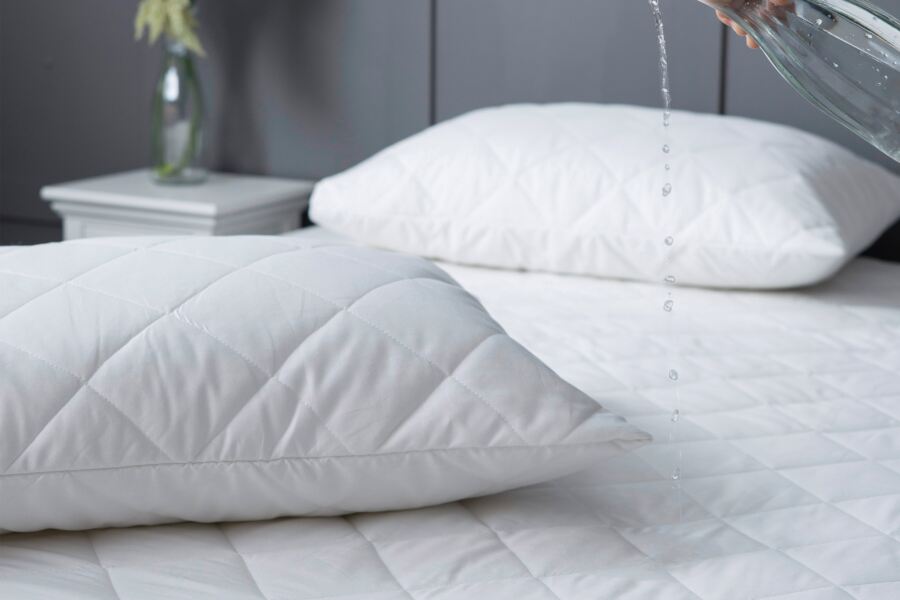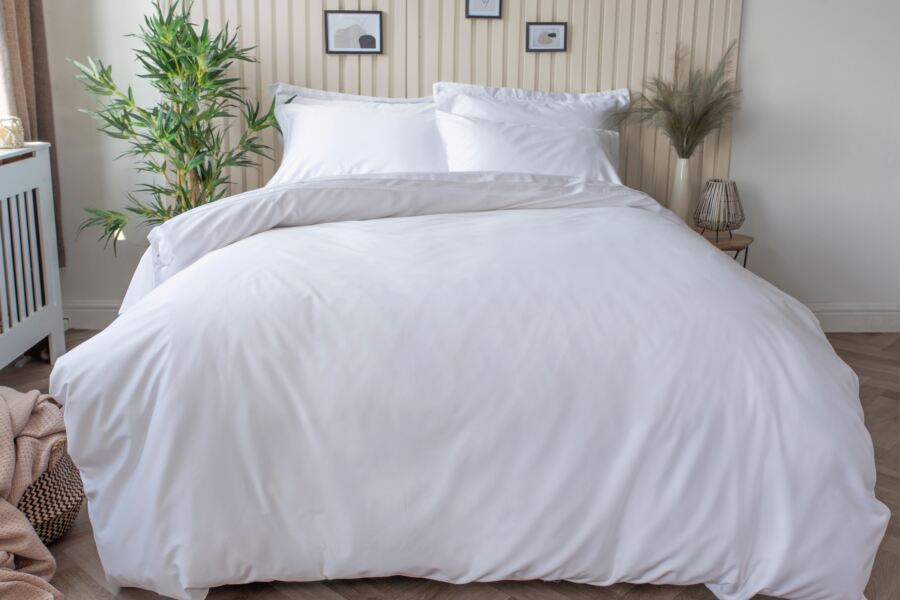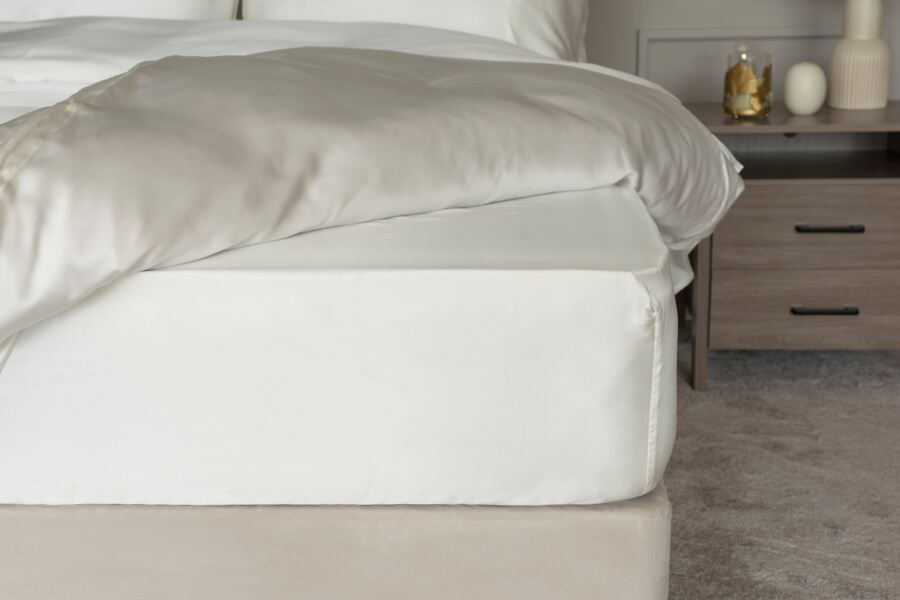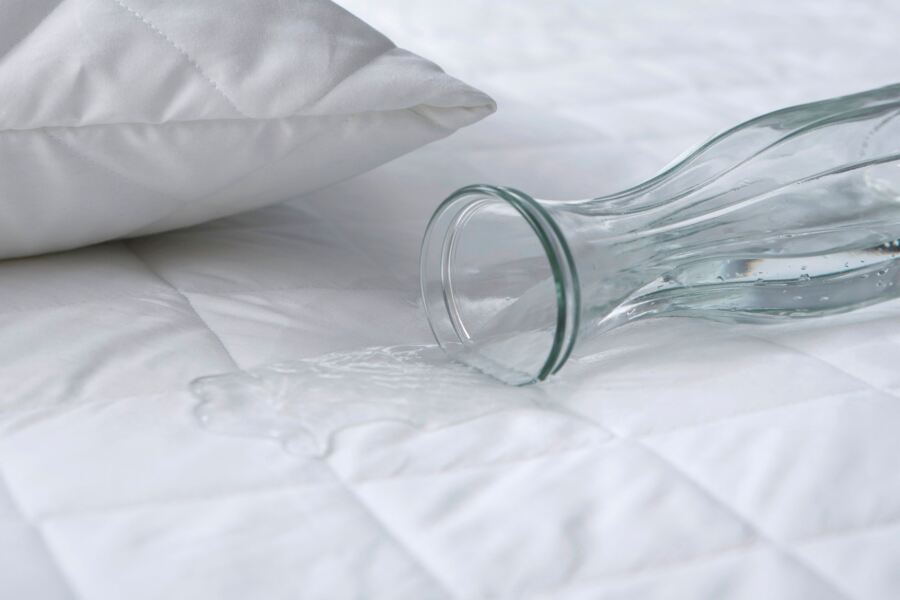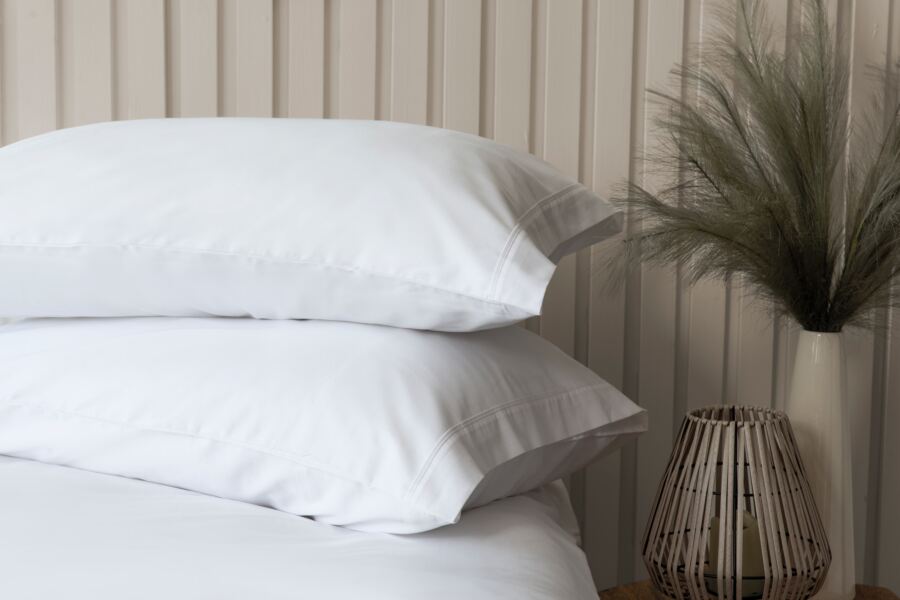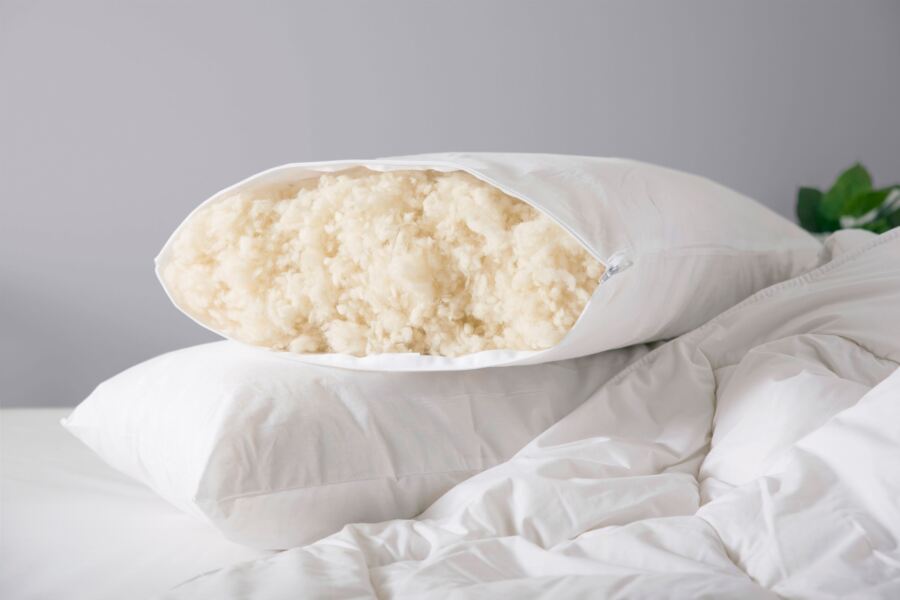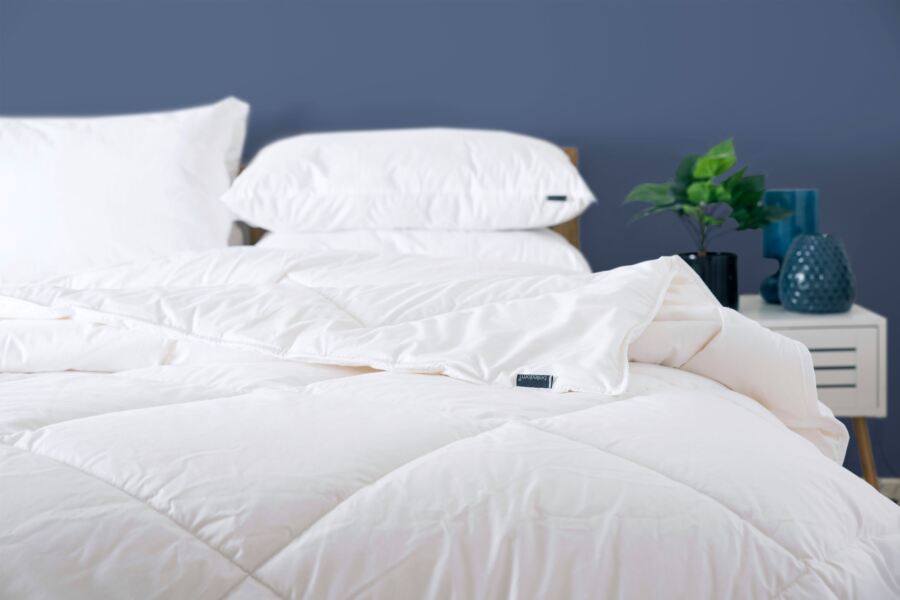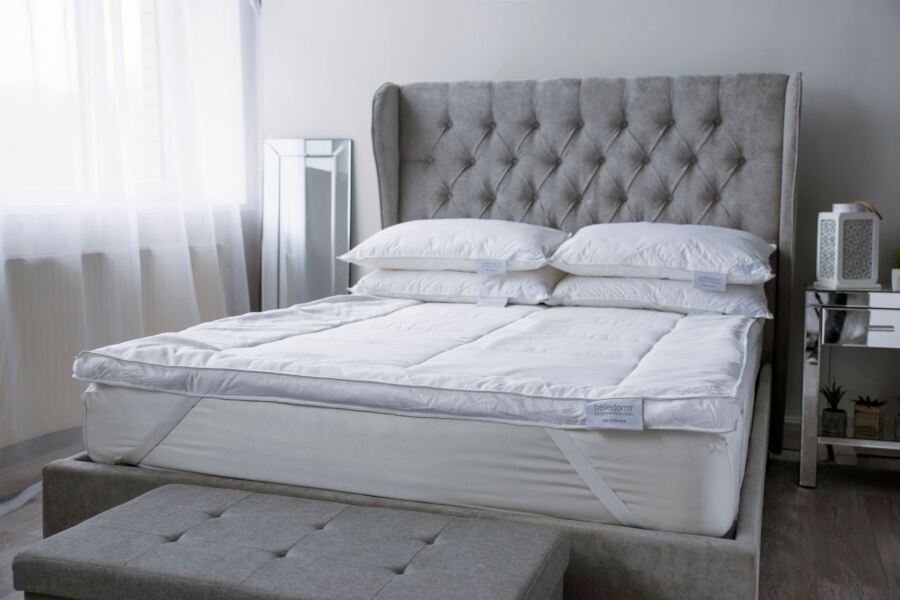Table of Contents
- Do You Need Anti-Allergy Bedding?
- Understanding Allergies and Bedding
- Allergy-Friendly Bedding Materials
- What Allergy-Free Bedding Do You Need?
- How to Choose the Best Anti-Allergy Bedding
- How to Make the Rest of Your Bedroom Allergy-Friendly
- FAQs
- Final Thoughts
Achoo! Is a runny nose and a tight chest keeping you awake at night? Or, are you waking up with swollen eyes and a blocked nose? Then you're not alone. There are plenty of allergy sufferers around the world who are experiencing the same symptoms as you are.
So, why should you care about your bedding when it comes to allergies? Well, for allergy sufferers, your bedding can either be your ally or your worst enemy in the battle against allergens. With pesky allergens like dust mites, mould, and pet dander, you're going to want to limit how many you have trapped in your bedding.
In this comprehensive guide to the best bed linen for allergies, we'll explore exactly what causes your allergies and what kind of bedding you need to finally get a good night's rest.

Do You Need Anti-Allergy Bedding?
Waking up to (or worse, being woken up by) uncomfortable allergy symptoms is one of the worst things that can happen to your sleep cycle. Some of these allergy symptoms may include itching, sneezing, coughing or a tight chest, watery and swollen eyes, and much, much more.
Thousands of people are sensitive to common household allergens like dust mites and dander, which can trigger allergy attacks at the most inconvenient of times - including in the middle of the night.
More than 40% of people in the UK suffer from allergic rhinitis (also known as hayfever or seasonal allergies), making it highly likely that you may also be suffering from allergies - you just didn't know it.
Luckily, allergic reactions can be reduced or eliminated if you make the switch to hypoallergenic bedding. Making the switch as a preventative measure can also be a smart thing to do. Rather than take the risk of having an unexpected allergic reaction, you can eliminate the possibility with hypoallergenic bedding.
Changing from regular bedding to anti-allergy bedding may seem like a daunting task, though, especially if you don't know where to start or what kind of bedding to look for. Perhaps the best place to start is by understanding where these allergies come from, and how they could potentially impact your health.
Understanding Allergies and Bedding
Anti-allergy bedding can be your secret weapon in your fight against allergens - made from tightly woven fabrics that act as a kind of force field that stops them from getting caught up in the material. But how do you pinpoint what type of allergic reaction you're having? And what role does your bedding play in making these allergies better (or worse)?
Understanding where your allergy symptoms are coming from and how they can impact your sleep is important to pick the right bedding. It can help you narrow down your search for anti-allergy bedding and prevent these nasty allergy symptoms from returning.
Common allergens in the bedroom
Several kinds of indoor allergens can cause nasty allergic reactions. But some types are worse than others - like the ones that find their way into your bedroom and cause plenty of sleepless nights.
Before you reach for your antihistamines to ease your allergy discomfort, you'll want to pinpoint what the underlying cause is. And, once you know that, you can start to give your bedroom a makeover and spruce it up into an allergy-free zone.
House dust mites
You're constantly shedding skin cells in your bed, and those creepy little critters called dust mites just love to feast on them. Yikes, right?! The rather unpleasant truth is that your mattress and pillow could be home to millions of house dust mites, which carry house dust mite allergens with them.
These allergens can produce uncomfortable symptoms, including
-
Watery eyes
-
Itchy skin or nose
-
A runny nose or congestion
-
A cough or a scratchy throat
-
Sinus pressure
If these allergy symptoms sound familiar, then your bed (including your bedding!) may be infested with house dust mites.

Mould
Mould allergies in your bedroom can be a real nuisance. Mould is a type of fungus that thrives in damp and dark environments. So, if your room is dark or not well-ventilated, you could be at risk of having mould grow in different corners of your room. What's worse is that it can also grow inside of material fibres, like those in your bedding, and potentially cause health issues - including allergies.
When these fungal spores are released, they can cause symptoms like
-
Itchy and irritated eyes
-
Congestion or a runny nose
-
Throat irritation
-
Coughing, sneezing and wheezing
Although you can reduce the amount of mould in your bedding by washing it regularly, the best way to prevent these allergens is to invest in anti-allergy bedding. You can also take care of the cause of the mould by making your room more allergy-friendly (but more on this later).
Animal dander
For some of us, letting our pets sleep on our bed with us is the norm. After all, how can you refuse their sweet little faces when they're asking to come up onto the bed with you? Even if you don't let your pets sleep beside you at night, having their pet beds in your room can be just as problematic when it comes to allergies.
Contrary to popular belief, it's not the animal's hair that is the culprit. Instead, it's tiny dead skin cells that contain proteins. When these cells are floating around your room or attach themselves to your bedding, it can trigger an allergic reaction.
Some of the pet dander allergy symptoms you may experience include
-
Wheezing and coughing
-
Sneezing
-
Itchy skin
-
Red and irritated eyes
-
Difficulty breathing and tightness in the chest (as a result of asthma)
How can allergies impact your sleep and overall health?
Some people may not be too phased if they experience some sneezing or a slight tingle on their skin when they're in bed. However, other allergy sufferers who experience more severe reactions may not see it the same way and be badly impacted by their allergy symptoms.
In cases of mild allergies, it's not unheard of for symptoms to snowball into bigger health problems. So, although you may only find your allergy symptoms to be a slight irritation (for now), you may want to be aware of the impact that these allergies can have on you over time if they're left untreated.
Interrupted sleep
Of course, the most obvious pain point that you're likely to experience as a result of allergy symptoms is broken sleep. Whether you're struggling to fall or stay asleep because of congestion or wheezing, it can be incredibly frustrating.
The impact on your sleep doesn't necessarily end there, though. As a result of poor or broken sleep, you may feel lethargic or fatigued throughout the day.
You may also be more likely to see a dip in your performance of daily tasks or even struggle with brain fog. Not having enough restful sleep has also been linked to poor mental health and higher levels of anxiety.
Asthma
Asthma symptoms that are more obvious at night (also called nocturnal asthma) can easily be triggered by allergens that get trapped in, live, or breed in your bedding. This is particularly true for house dust mites.
These allergens can irritate and inflame your airways, which can cause nocturnal asthma. The symptoms of this condition go hand-in-hand with more severe allergy attacks, like shortness of breath, wheezing, coughing, and a tight chest.
Removing your current bedding and replacing it with hypoallergenic bed sheets and duvets is the easiest way to ease your allergies straight away. And, although it may not remove them altogether (unless you remove the sources from the rest of your environment), you'll definitely be able to sleep easier than before.
Allergy-Friendly Bedding Materials
When it comes to getting a good night's sleep without the annoyance of allergies, the bedding you choose is a big deal. There are tons of material options, each with its own unique perks. From the cosy luxury of silk to the eco-friendly nature of bamboo sheets, there's a material to suit anyone's needs (and budget).
But narrowing down your search for the perfect material for you can be tricky. So let's take a closer look at each of these anti-allergy bedding materials and how you can benefit from dressing up your bed in any one of these fabrics.
Silk
Silk is an incredible, naturally hypoallergenic material that is soft and comfortable. This makes it fantastic for people with sensitive skin. What sets silk apart isn't its comfort, though (although it certainly helps). Instead, it's that silk works perfectly for anti-allergy bedding.
The reason it's so effective against allergens - particularly house dust mite allergens - is because of the origin of silk. Silkworms produce silk fibres in a cocoon, which is naturally designed to protect them from predators. This translates into the tightly woven fibres that make up silk bedding and create a defensive barrier against dust mites.
It's important to remember that while silk bedding is great for staving off allergens, it also requires maintenance and care to retain these properties. Silk is also one of the more expensive options for hypoallergenic bedding. However, if you want a blend of luxurious fabric and allergy relief in your bedroom, silk is an excellent choice.
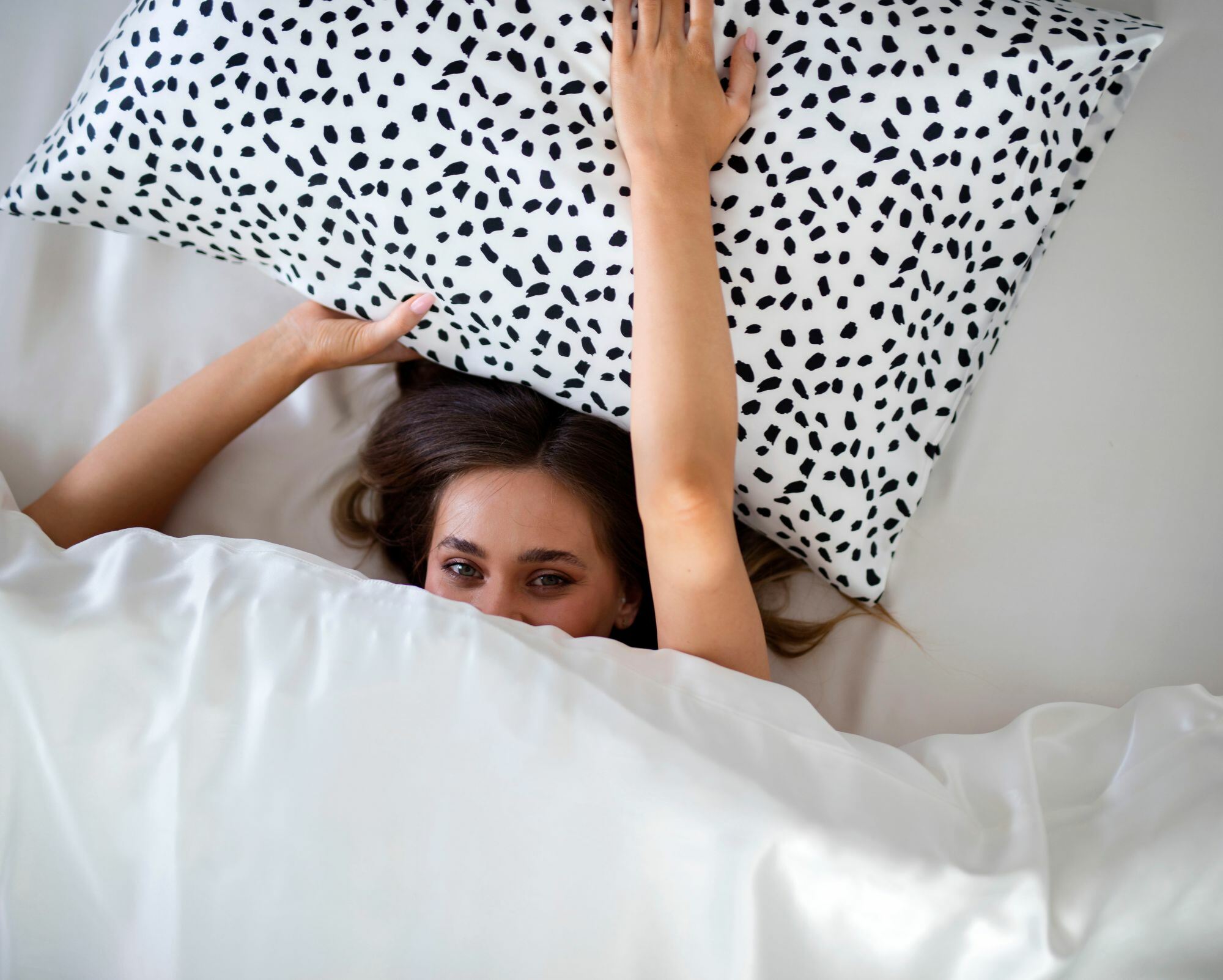
Bamboo
Bamboo sheets and other bedding have become a lot more popular over recent years thanks to their sustainable production, eco-friendly manufacturing, and their soft, plush feel. However, it's essential to look for high-quality bamboo bedding, since there are some manufacturers that use harsh chemicals in the manufacturing process (despite their eco-conscious labels).
These sheets are made from the natural plant fibres of the bamboo plant and offer several benefits for allergy sufferers, including those with sensitive skin.
One of the main advantages is its natural moisture-wicking ability. Bamboo sheets help to keep you cool and dry, which is especially useful for discouraging the growth of mould and preventing dust mites from thriving in a humid environment.
Additionally, bamboo sheets are highly durable and have a soft, elegant texture that can help you get a good night's sleep. Like silk, bamboo needs to be properly cared for if you're using it for anti-allergy bedding. To avoid having allergic reactions in the future, you will still need to wash your sheets regularly and store them properly when you're not using them.
Tencel
Another amazing material that makes for great hypoallergenic sheets is Tencel. This fabric, made from the wood cellulose of eucalyptus trees, is typically grown on sustainable farms. So, if you're interested in an eco-friendly and sustainable product to cover your bed with, then this is the fabric for you.
Tencel sheets are incredibly soft and feel like heaven against your skin. Like bamboo, Tencel has the ability to draw moisture away from your body. This means that it creates an environment that is less conducive to germs, bacteria, and (of course) indoor allergens like dust mites.
Because of the complex production processes that are used to make Tencel, they're also among some of the more expensive options for anti-allergy bedding. Nevertheless, this hypoallergenic bedding is ideal for anyone who suffers from allergies. Plus, if you want to invest in a slightly more pricey bedding option that is going to last, Tencel's long lifespan makes it worth the price point.
Organic cotton
Organic cotton is a classic, tried-and-true fabric that offers several hypoallergenic advantages. It should come as no surprise that this lightweight material is praised for its breathability. It allows for air to circulate more freely without trapping too much heat against your body, which, in turn, prevents moisture from forming on your skin.
Since organic cotton can help you regulate your temperature, it is less likely that you'll suffer from those dreaded night sweats, which means that you won't have to worry about dust mites and mould breeding in your bedding.
Additionally, organic cotton is grown without the use of pesticides and is free from harmful chemicals like bleach and formaldehyde that are typically used during the finishing process of synthetic materials. Still, you'll need to consider the type of cotton you choose when you're investing in your new anti-dust mite bedding.
Long-staple or extra-long staple cotton sheets are smoother and more durable than short-staple cotton, making them better picks for comfort and longevity. Coupled with the fact that organic cotton is more widely available than other materials and, therefore, more affordable, this hypoallergenic bedding is perfect for keeping your night-time allergy symptoms at bay.
Linen
Linen is another plant-based material (made from flax plant) that makes for the perfect anti-allergy bedding. The production process for flax plants uses less water and pesticides than other crops, which means it's highly unlikely that any of these nasty chemicals will be trapped in the fabric once it's processed.
Usually, harsh chemicals can cause itching and irritation for people with sensitive skin. But you can rest easy knowing that pure linen can actually feel soothing and smooth against your skin. It is a hypoallergenic material that offers a unique blend of comfort, breathability, and longevity.
Linen sheets are highly sought-after because of their ability to keep you cool and dry all night long, making them a perfect pick for allergy-friendly bedrooms. Its breathability allows for air to flow freely through the weave of the fabric, which again stops moisture from building up beneath your bedding. That means you can confidently say goodbye to dust mites and other allergens!
While linen may feel a little rough at first, the material is known to get softer over time and with every wash. Since you'll need to wash your bedding more frequently to keep allergens out of the fibres of the fabric, you won't have to wait for long before your sheets are soft and comfortable.
Microfibre
Microfibre is a synthetic material that is known for being a tightly woven fabric, which helps to keep allergens and dust mites out of your bedding.
While this may not be the most luxurious fabric when you compare it to some of the others on this list, it is an excellent choice for practicality. It's durable, affordable, and easy to care for and works perfectly for anti-allergy bedding.
The type of microfibre bedding you buy makes a difference, though. There are some variations that are known as 'brushed microfibre'. These sheets may seem appealing for the winter months since they're fuzzier and warmer than standard microfibre bedding.
However, the fuzz can actually trap even more allergens in the fibres, which means it can make your allergies worse. So if you're on a budget and you're opting for microfibre anti-allergy bedding, just be careful to pick the right type. Otherwise, you may be stuck with your allergy symptoms and more sleepless nights.
Wool
As an alternative to brushed microfibre, you don't get much better than wool. It's natural and hypoallergenic with some unique characteristics that make it ideal if you suffer from allergies.
Firstly, wool is naturally resistant to mould and dust mites, which makes it an effective solution for keeping these pesky allergens out of your bedding. Wool pillows and duvets, in particular, can be great for keeping your sleep environment clean and maintaining a comfortable temperature.
While some people might associate wool with warmth, it's actually a great bedding choice for year-round temperatures. It can effectively regulate your body temperature and stop you from getting too hot or too cold and it is much more breathable than it seems.
Additionally, wool has anti-microbial properties, which means that it is resistant to bacterial growth. Of course, this only adds to how well it fights off allergens. It also repels moisture, which means dust mites will struggle to survive in the fabric. No more waking up with a stuffy nose!
What Allergy-Free Bedding Do You Need?
Picking the best hypoallergenic bedding starts with knowing what materials to look for. Luckily, we've already covered the materials that will help to keep allergens at bay. Now, it's time to strip your bed and start fresh by dressing it up from top to bottom with all-new anti-allergy bedding.
Get ready to make a shopping list of everything you'll need, because we're about to dive under the covers and discuss the most essential items you can use to spruce up your bed.
Duvets and duvet covers
Duvets, while cosy, can be the worst bedding to have as they act like a hotel for dust mites and other allergens. This only works to make your allergies worse! But you don't have to look for other bedding options just yet.
Instead, you can opt for anti-allergy duvets made from hypoallergenic materials. Look for duvets that are breathable and have natural fibre fillings like wool. You can also check the labels of any anti-allergy duvets you find and look for words like 'hypoallergenic' or 'anti-microbial'. This will let you know that you're on the right track.
The best kind of duvet you can buy for allergies, though, is a wool duvet. Because it helps to keep bacteria and dust mites at bay, you won't have to worry about having a bad allergic reaction in the middle of the night anymore. Plus, it works for any season, which means you won't have to switch it out for a summer duvet when the warmer months come along.
It's important to remember that you can also add an extra layer of protection with an anti-allergy duvet cover, which will help to keep allergens out of your duvet for longer. You can also wash a duvet cover in the washing machine, which makes it easier to maintain your bedding.
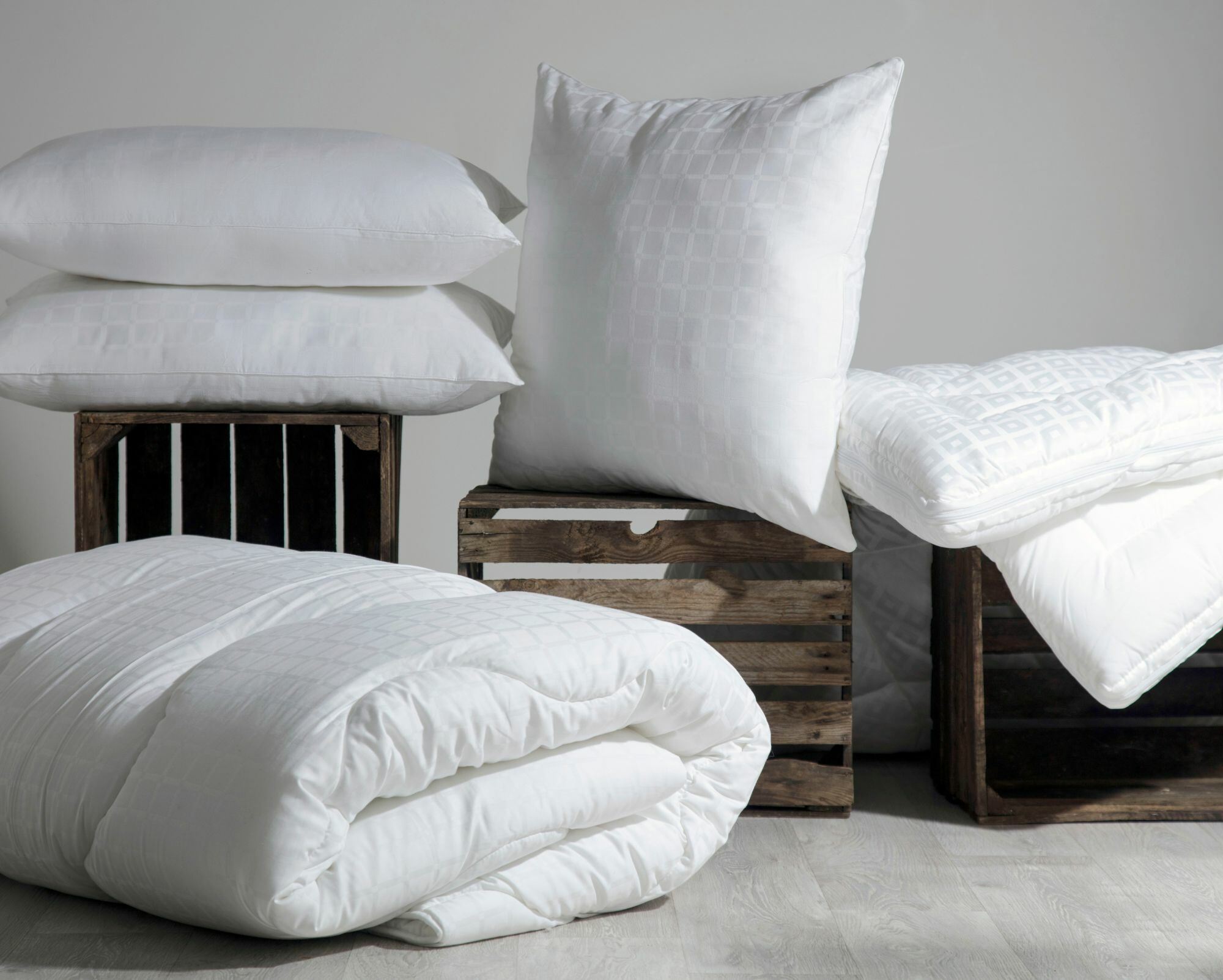
Pillows and pillowcases
Since you spend a significant time with your head on a pillow, it can quickly become a hotspot for dust mites and mould. And, with your face so close to these allergens, it's no wonder that you're waking up feeling congested.
Anti-allergen pillows are specifically designed to help ease your symptoms. This is because they're made to prevent bacterial growth and repel moisture, which makes for a more comfortable sleeping environment altogether.
Of course, anti-allergy pillows can be quite costly depending on the brand and material. So, when you're investing in these pillows (or if you just want to prevent allergies using your existing pillow), it is important to protect them as well. To do this, you can use high-quality pillow protectors or anti-allergy pillowcases.
This boosts the shielding properties of your pillow. Plus, it is easier to remove a pillow protector and throw it in your washing machine than it is to wash your entire pillow. In fact, some pillows can't be washed at all, so using some form of coverage or protection is a good way to help your pillow retain its allergy-busting qualities while also keeping your bedding clean and fresh.
Sheets
When it comes to choosing your sheets, the type of material you choose matters. You're going to want to opt for hypoallergenic sheets that are made from the materials we've listed above. These fabrics can help to reduce the amount of allergens that can cling to your sheets, making it harder for dust mites and other allergens to thrive.
It's important to remember that you will need to wash your sheets regularly, though, no matter which material you choose. This can help to rid them of any allergens that have found their way into the fabric, or that may have been left behind on the material (like pet dander).
If you have sensitive skin, you should also choose hypoallergenic sheets to help soothe your skin and prevent itching and irritation.
Mattress protectors
Mattress protectors are fantastic for any sleeper but can be especially important for people who are prone to allergies. Since mattresses can be the main perpetrators in harbouring dust mites, safeguarding yourself and your mattress from them is essential.
Ideally, you'll want to choose one that is breathable and - more importantly - waterproof. This can help to allow more air to circulate through the mattress and stop moisture and spills from causing mould.
Natural fabrics like organic cotton or Tencel are excellent choices for mattress protectors. You'll also want to look for one that covers the entire mattress. That way, you can rest easily knowing no pesky dust mites are infiltrating your sleeping surface.
How to Choose the Best Anti-Allergy Bedding
Now that you have a better understanding of what to look for in anti-allergy bedding, you can start the hunt for your new bedcovers. By following the steps below, you can make sure that you're choosing the best hypoallergenic bedding that suits your needs and can help ease your allergy-related symptoms.
Identify the cause of your allergies
The first thing you'll need to do is pinpoint the cause of your allergies. This can help direct you to the right bedding since you'll need to look for qualities that complement what you're trying to combat.
For example, hypoallergenic sheets that are made from moisture-wicking material can help to reduce house dust mite allergens, since dust mites thrive in humid environments. This means that fabrics like bamboo and wool would be best suited to your needs.
Pick the right materials
Look for bedding made from naturally hypoallergenic materials, like organic cotton or Tencel. Since these materials have a natural ability to keep allergens out of their fibres, they are likely to work well for keeping your bed an allergy-free zone.
You can also check the labels of your anti-allergy bedding. Keep an eye out for certifications that guarantee that the bedding is hypoallergenic and allergy-friendly. For instance, hypoallergenic sheets that are endorsed by Allergy UK are a safer choice than products that don't have any endorsements.
Consider weave and thread count
Although weave and thread count doesn't matter as much as the material when it comes to anti-allergy bedding, it can still influence your decision in your quest to rid your bedroom of sniffles-inducing indoor allergens.
You should try to choose hypoallergenic bedding with a tight weave and a good thread count since they can both create a barrier against dust mites. Percale and sateen weave sheets are the top choices because they're usually tightly woven.
Percale sheets have a matte finish and a crisp, cool feel that soothes sensitive skin. This weave creates a lightweight, breathable fabric that is ideal for hot sleepers and warmer climates. On the other hand, sateen sheets tend to be softer and more luxurious to the touch, making it a popular choice if you tend to prioritise comfort.
Don't forget your mattress or pillows
While changing your bedding is a good place to start, you don't want to forget about protecting your pillows and mattress. Otherwise, you're leaving them exposed to dust mites and your allergies may even get worse.
When you're replacing your bedding, you always want to make sure that you're covering all your bases - literally! You may also want to reassess your sleeping environment, including your bedroom (but we'll get to that in a bit).
Consider the longevity of your anti-allergy bedding
Your new anti-allergy bedding is only as good as your care routine. To help it retain its allergy-fighting properties, you'll need to wash your bedding regularly. However, frequent washing can cause some fabrics to break down more quickly. So, how do you find the perfect balance?
Well, by buying bedding that is durable and that can hold up against regular washing. Linen bedding is the perfect example. The more you wash it, the softer it gets! It also retains its shape and will last for years if you maintain it correctly. The same is true for strong, high-quality materials like wool and bamboo.
How to Make the Rest of Your Bedroom Allergy-Friendly
Besides changing your bedding (and washing it regularly), there are some other things to do to safeguard your room against allergens. If you combine new bedding with some of these techniques, you're likely to get more restful sleep night after night.
Declutter your room
It may not come as a surprise, but clutter has a tendency to accumulate dust. And there are some objects that can attract dust mites, like extra throw pillows, blankets, and stuffed animals that sit around your room.
If you're not using certain pillows or blankets, it may be a good idea to pack them away and store them until you need them. Otherwise, you're just allowing dust-magnets to draw more allergens onto them and increasing the risk of airborne allergens floating around your bedroom.
Use an air purifier or filter
Using an air filtration or purifying system can be really beneficial in combating indoor allergens. These handy little devices are designed to remove airborne allergens from your space, including dust, mould spores, and pollen.
You'll need to look for air purifiers that have small-particle or high-efficiency particulate air (HEPA) filters since they're the most effective at ridding the air of these allergens. You should also run it regularly to clear the air you breathe, especially before you go to bed at night.
Vacuum regularly
Like air filters, you can get vacuum cleaners that have HEPA filters. However, even vacuums without a filter can help to clear up any dust that has settled on your floors.
If you have pets or carpets, you should aim to vacuum your room at least once a week. Dust mites can find their way into carpets and make a home there, so regular vacuuming can help eliminate these unwanted creepy crawlies.
Replace other fabrics in your room
Your bedding isn't the only thing that can store dust mites and capture pet dander or mould. You also need to assess other fabric-based items in your room like your curtains or blinds. Carpets, fabric chairs, and even fabric tapestries on your wall are at risk of becoming a hotel for dust mites.
To help eliminate the possibility of these items causing an allergy flare-up, you'll want to wash them as often as possible. For fabric chairs, you should vacuum them using the fabric-head attachment of your vacuum cleaner.
Manage the humidity
Dust mites thrive in warm, humid conditions. That is why they are so drawn to your bedding - especially in the hot summer months when you're more prone to sweating at night! Just having too much humidity in your room can lure them and cause them to burrow into any surfaces they can.
If you have access to a dehumidifier, this can help to reduce the possibility of having these critters living in your room (rent-free!). Ideally, you'll want to keep the humidity levels in your room between 30% and 50% to discourage allergen growth.
Keep your windows closed
During high pollen seasons, which are dreaded by people who suffer from allergies, you'll want to keep your windows closed. This can prevent pollen from entering your bedroom to lessen the amount of airborne allergens while you're trying to fall asleep.
You definitely don't want outdoor allergens mixing with those that are already more common indoors! It is a recipe for disaster and a surefire way to make your allergies worse.
Place pet beds outside the bedroom
As much as you love your pets, having them in your bedroom can increase the chances that you're going to struggle with night-time allergies. If your pets already sleep on their own beds, then you may want to consider moving their beds out of your room. This can reduce the amount of pet dander in your bedroom, making it easier to keep your room allergy-free.
FAQs
How often should I replace my bedding for optimal allergy relief?
To get rid of night-time allergies, it is best to wash your sheets, pillow covers, and duvet covers regularly with hot water.
However, you should still completely replace your bedding every once in a while. For example, you should ideally replace your pillows around once every one to two years.
Mattresses have a lifespan of eight to 10 years or more, but using mattress protectors or covers can help to extend their longevity even more and reduce the buildup of allergens.
Can allergy-friendly bedding help with asthma symptoms?
Anti-allergy bedding, like hypoallergenic bed sheets and pillowcases, can be beneficial for people who suffer from allergies and asthma. These products are designed to create a barrier that reduces your exposure to common asthma triggers, like dust mites and animal dander.
While they may not completely eliminate asthma symptoms, they can help reduce the frequency and severity of any asthma attacks that you may have. In turn, it will be easier for you to breathe more comfortably while you sleep.
What's the difference between hypoallergenic and regular bedding?
Hypoallergenic bed sheets and other bedding are usually made with specific materials and are designed in a way that repels allergens. This can help to keep house dust mites, mould, and other common allergens from growing inside of your bedding and causing late-night allergic reactions. The same is true for anti-allergy pillows and mattresses.
On the other hand, regular bedding is made with different materials and doesn't have any protective barriers that stop dust mites from reproducing and triggering your allergies. So, if you find yourself waking up with a tight chest, sniffles, or itching skin, it may be time to switch to hypoallergenic bedding.
Final Thoughts
Picking the right bedding is a game-changer when it comes to enjoying a sneeze-free, restful night's sleep. Allergies can turn a cosy night into a miserable nightmare. Thankfully, now that you know the secrets of transforming your bedroom, you can finally go to bed free of congestion and without waking up with a scratch in your throat.
At Belledorm, we're committed to helping you boost your sleep quality - not only with high-quality bedding, but with expert advice, tips, and tricks. Using this guide will help you enjoy a night free from allergies. And the best news? You can get all of your new anti-allergy bedding from our website with no hassle or shopping around.

